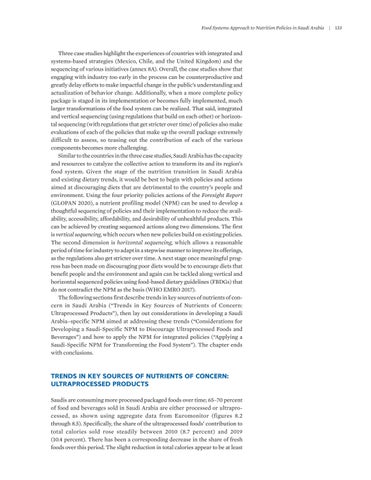Food Systems Approach to Nutrition Policies in Saudi Arabia
Three case studies highlight the experiences of countries with integrated and systems-based strategies (Mexico, Chile, and the United Kingdom) and the sequencing of various initiatives (annex 8A). Overall, the case studies show that engaging with industry too early in the process can be counterproductive and greatly delay efforts to make impactful change in the public’s understanding and actualization of behavior change. Additionally, when a more complete policy package is staged in its implementation or becomes fully implemented, much larger transformations of the food system can be realized. That said, integrated and vertical sequencing (using regulations that build on each other) or horizontal sequencing (with regulations that get stricter over time) of policies also make evaluations of each of the policies that make up the overall package extremely difficult to assess, so teasing out the contribution of each of the various components becomes more challenging. Similar to the countries in the three case studies, Saudi Arabia has the capacity and resources to catalyze the collective action to transform its and its region’s food system. Given the stage of the nutrition transition in Saudi Arabia and existing dietary trends, it would be best to begin with policies and actions aimed at discouraging diets that are detrimental to the country’s people and environment. Using the four priority policies actions of the Foresight Report (GLOPAN 2020), a nutrient profiling model (NPM) can be used to develop a thoughtful sequencing of policies and their implementation to reduce the availability, accessibility, affordability, and desirability of unhealthful products. This can be achieved by creating sequenced actions along two dimensions. The first is vertical sequencing, which occurs when new policies build on existing policies. The second dimension is horizontal sequencing, which allows a reasonable period of time for industry to adapt in a stepwise manner to improve its offerings, as the regulations also get stricter over time. A next stage once meaningful progress has been made on discouraging poor diets would be to encourage diets that benefit people and the environment and again can be tackled along vertical and horizontal sequenced policies using food-based dietary guidelines (FBDGs) that do not contradict the NPM as the basis (WHO EMRO 2017). The following sections first describe trends in key sources of nutrients of concern in Saudi Arabia (“Trends in Key Sources of Nutrients of Concern: Ultraprocessed Products”), then lay out considerations in developing a Saudi Arabia–specific NPM aimed at addressing these trends (“Considerations for Developing a Saudi-Specific NPM to Discourage Ultraprocessed Foods and Beverages”) and how to apply the NPM for integrated policies (“Applying a Saudi-Specific NPM for Transforming the Food System”). The chapter ends with conclusions.
TRENDS IN KEY SOURCES OF NUTRIENTS OF CONCERN: ULTRAPROCESSED PRODUCTS Saudis are consuming more processed packaged foods over time; 65–70 percent of food and beverages sold in Saudi Arabia are either processed or ultraprocessed, as shown using aggregate data from Euromonitor (figures 8.2 through 8.5). Specifically, the share of the ultraprocessed foods’ contribution to total calories sold rose steadily between 2010 (8.7 percent) and 2019 (10.4 percent). There has been a corresponding decrease in the share of fresh foods over this period. The slight reduction in total calories appear to be at least
|
133






